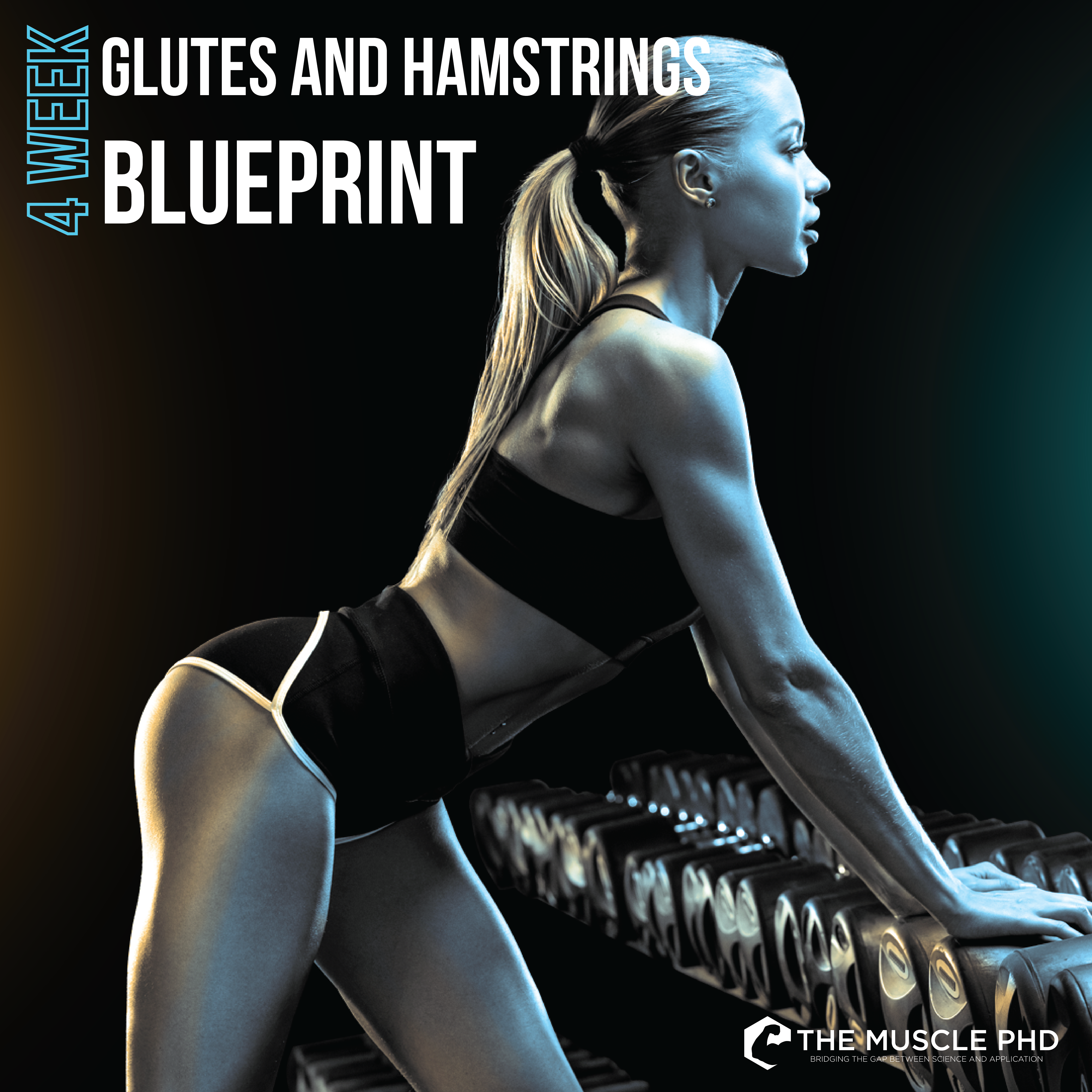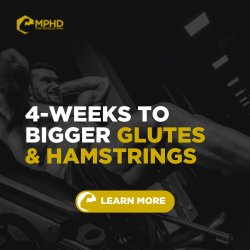Introduction
In this piece we’re going to cover a study that’s hot off the press: “Back Squat vs. Hip Thrust Resistance-training Programs in Well-trained Women” by Barbalho et al. (2020). These authors designed a 12-week training program with trained female subjects comparing hip thrusts vs back squats and examined both strength and glute muscle gains from each respective exercise.
We’ve seen both the rise and fall of the “She Squats” campaigns, and now hip thrusts have seemingly taken over as the superior booty exercise. Before we get into the findings of this study, let’s cover the background info on why we’d even compare the two in the first place.
Background
An important note to cover here is that the hip thrust is a relatively new exercise in the strength and conditioning research field. Many credit Dr. Bret Contreras with the “invention” of the hip thrust, but it’s likely that athletes and bodybuilders have been doing some sort of version of this exercise for quite a few years. However, Dr. Contreras has contributed a substantial amount of research on the exercise, so he’s certainly the expert to look to in matters involving butts.
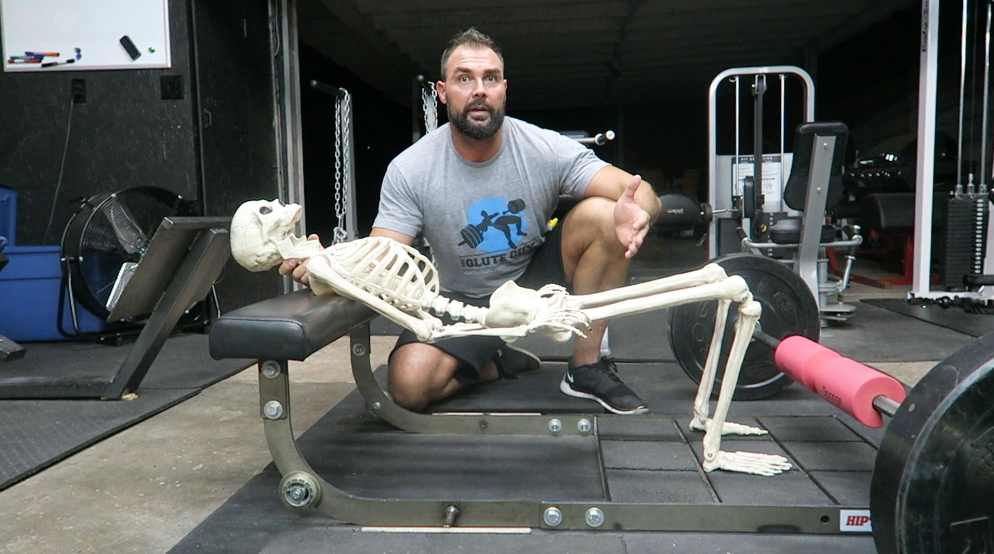 With that out of the way, what initial directions did the research point us in? Dr. Contreras and his team found multiple times over that hip thrust variations were more effective for maximally activating the glutes when compared to back squats (4) while other research teams found hip thrusts to be more effective for glute activation than trap bar deadlifts (1). In addition, we have studies showing that hip thrusts can have a large carryover into athletic performance (5, 12) due to their different biomechanical nature when compared to squats.
With that out of the way, what initial directions did the research point us in? Dr. Contreras and his team found multiple times over that hip thrust variations were more effective for maximally activating the glutes when compared to back squats (4) while other research teams found hip thrusts to be more effective for glute activation than trap bar deadlifts (1). In addition, we have studies showing that hip thrusts can have a large carryover into athletic performance (5, 12) due to their different biomechanical nature when compared to squats.
What is the reason for these findings? It’s worth going back to biomechanical models, as these models can often be extremely indicative of what joint angles are optimal for muscle development. Research has shown that the glutes are easily the primary hip extensor when the hips are near full hip extension (3). This is both due to the fact that the glutes have the greatest internal moment arm in this position and the other hip extensor muscles, the adductors and hamstrings, have a reduced internal moment arm in this position. This means that exercises that emphasize hip extension near full hip extension, such as hip thrusts, are likely going to be more effective for activating the glutes.
While muscle activation studies aren’t always the end-all, be-all for uncovering effective exercises, combining activation data with biomechanical models can often lead us closer to this knowledge. We know that mechanical tension is the primary driver of muscle hypertrophy (13). For a muscle to experience greater mechanical tension, it should A) be active, and, B) be in a position in which it is greatly contributing to force production (AKA, a large internal moment arm). The hip thrust should satisfy both of these requirements, so let’s see how it performs in the Barbalho et al. (2020) study.
Findings of New Study
Like we’ve already mentioned, these researchers used trained women for this study. These women were mostly in their mid- to late-20s and had back squat and hip thrust 1RMs of around 92kg (202lbs) and 99kg (218lbs) respectively. They split the women into two groups; one group performed solely back squats for 12 weeks whereas the other group performed just hip thrusts for 12-weeks. Training was performed once per week with six sets on each exercise per week. The program was also periodized in which volume undulated on a weekly basis, i.e. the participants performed a mixture of high, moderate, and low reps throughout the study. Besides a pretty low overall weekly training volume (6 sets), everything here looks pretty good so far.
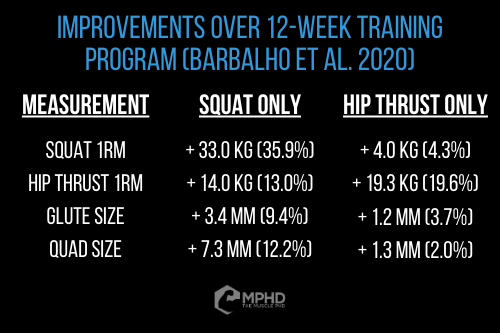 Following the training program, Barbalho et al. (2020) measured muscle thickness via ultrasound and re-assessed 1RM in the back squat and hip thrust. As you can see in the picture, the back squat group made much better quad, glute, and squat 1RM gains whereas the hip thrust group only made slightly better (but not significantly better) gains in hip thrust 1RM.
Following the training program, Barbalho et al. (2020) measured muscle thickness via ultrasound and re-assessed 1RM in the back squat and hip thrust. As you can see in the picture, the back squat group made much better quad, glute, and squat 1RM gains whereas the hip thrust group only made slightly better (but not significantly better) gains in hip thrust 1RM.
So, wait…
Squats are better for glute growth than hip thrusts? Have we all been wrong the past 10-years? This questioning sent me into a little dig – how was the rest of the community reacting to these findings? Since this is a pretty recent paper, there hasn’t been much noise on it yet (we’ll update this article when there’s more reactions). However, Menno Henselmans has offered his thoughts on the paper (10). I usually respect Menno’s opinion on things and he’s quite the statistics and methods wiz so I was curious if he had any thoughts to the contrary about these findings.
Menno didn’t seem to have any problems with the statistics or study methods. However, his one criticism of the study was that the women in the study were rather strong and, therefore, he wondered if they were on drugs. While drugs wouldn’t necessarily skew the findings towards one exercise or the other, this thought is, frankly, ridiculous. Since when do we accuse women who squat ~200lbs of being on drugs? I really do respect Menno, but c’mon, dude.
Menno does make a good point that the subjects made substantial gains on a pretty low training volume, especially for trained individuals, and that certainly is an interesting note. However, one of the authors of the paper, Paulo Gentil, has often been staunchly against drug use in bodybuilding (7,8) and I highly doubt he would allow drug use (reported or unreported) in any study he puts his name on. The authors also mention that they routinely questioned the subjects about ergogenic aid use throughout the study, but they don’t report the outcomes of these questions. Nor do they report nutrition data or training information outside of the study, i.e. we don’t know if subjects continued training outside of the lab. Both of these are incredibly interesting notes and could certainly influence gains, however, they still don’t exactly explain the drastic differences seen between the squat and hip thrust group.
Nevertheless, a 36% increase in squat 1RM over a 12-week training is pretty impressive – especially when subjects are only performing 6 sets of squats per week. The improvement itself isn’t underheard of; I’ve seen similar improvements in my former collegiate female teams in a semester of training (often 30-37%), but we did a lot more than just 6 sets of squats per week. Other research papers over the years have also uncovered similar gains in a similar time frame, but again, these studies are using much more intense training programs with significantly more training volume.
Another interesting note is that the hip thrust group supposedly didn’t make significant gains in squat 1RM. While I wouldn’t expect to see massive gains as there’s not a ton of carryover between exercises here, we still somehow get opposing results with the squatters making significant gains in hip thrust 1RM. We do have one more lone study that examined squat 1RM following hip thrust training and that study did find a significant improvement – to the tune of 31% in 8-weeks of training 3x/week (12). In addition, we have other studies showing that 6-weeks of hip thrust training crushed front squat training for hip thrust 1RM gains (49.5% vs 17.4%) (5). So, really, these strength results are rather curious and I look forward to seeing if the authors disclose further information about these numbers.
Science vs Anecdote
While the strength numbers are more interesting, let’s get back to the matter at hand: glute growth.
This is one of only a few studies that directly measure glute hypertrophy via ultrasound. One reason for this is that we don’t have a perfect methodology for measuring glute hypertrophy since the glutes are such a large and thick muscle group. In addition, doing an ultrasound on someone’s butt is a little personal – especially with female subjects and male researchers. Regardless, we do have one other recent study that found that deep squats were very effective for increasing glute size (11).
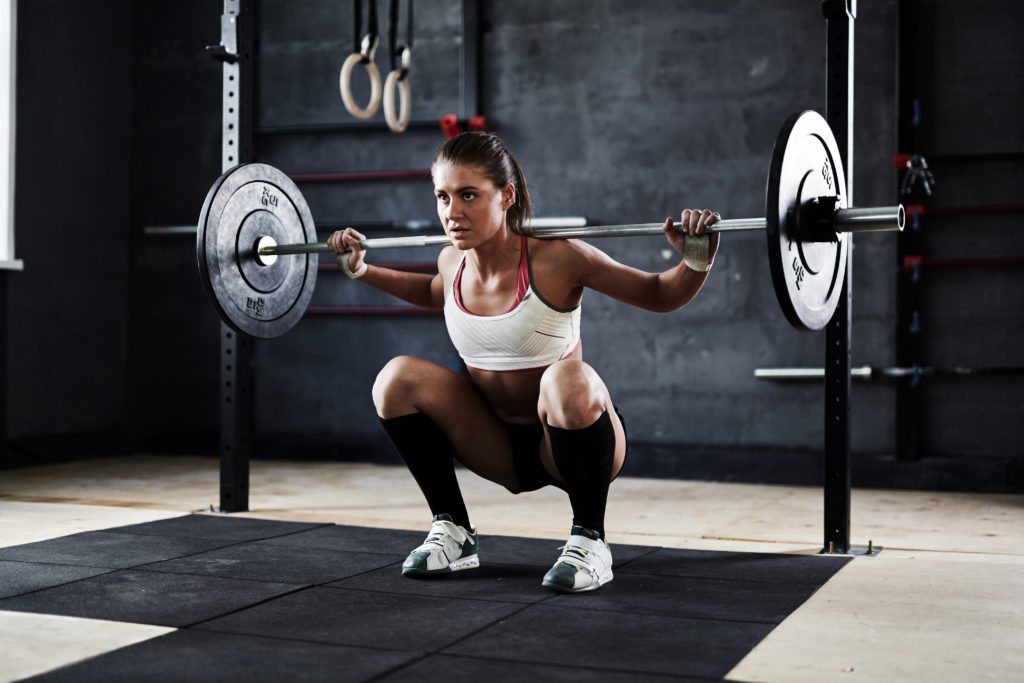 Really, no one is arguing the fact that deep squats can still improve glute size and aesthetics, however, the general consensus of the bodybuilding community is that hip thrust variations are typically better for glute development than squats. Now, I think one major variable that plays a role in these anecdotal reports is the fact that hip thrusts are often a novel exercise for people. Just about everyone learns how to squat early on in a training program, but hip thrusts are typically an exercise they undertake after a few months or even years of training. Simply adding a new exercise probably plays a pretty big role in these anecdotal reports.
Really, no one is arguing the fact that deep squats can still improve glute size and aesthetics, however, the general consensus of the bodybuilding community is that hip thrust variations are typically better for glute development than squats. Now, I think one major variable that plays a role in these anecdotal reports is the fact that hip thrusts are often a novel exercise for people. Just about everyone learns how to squat early on in a training program, but hip thrusts are typically an exercise they undertake after a few months or even years of training. Simply adding a new exercise probably plays a pretty big role in these anecdotal reports.
Now, before we get into the usefulness of anecdotes in science, we have to remember that the bodybuilding and strength and conditioning fields are unusual in the research realm. Application often happens years before research can support it – i.e. bodybuilders were doing things in the gym in the early 2000s that we’re just now getting around to studying and confirming. Multiple coaches have offered the quote that, “science doesn’t understand sport.” This leads us to our next set of thoughts.
While many researchers, such as Dr. Wilson on this site, take pride in examining actual bodybuilding practices to uncover more information, other researchers seem to take a different stance. Paulo Gentil, as we mentioned earlier, is one such of these researchers. Gentil’s lab is famous for producing studies finding that adding isolation exercises to a training program isn’t more effective for growth than just doing compound movements in both untrained (9) and trained (6) men. In addition, Gentil has been critical of common bodybuilding practices and has suggested that bodybuilders skip isolation exercises and reduce protein intake (beyond 1.6g/kg) in lieu of greater carbohydrate intake (7).
While I find that being critical of researchers does little for the community, these findings and suggestions are simply absurd and highlight a common chasm between researcher and athlete. Bodybuilders have utilized isolation exercises for several decades and have also known the benefits of high protein intake when considering body composition. Attempting to publish findings contrary to these practices or suggest alternate (and ineffective) methods of getting shredded does absolutely nothing for progressing the field forward. I’m not saying we need to scientifically confirm everything that bodybuilders practice, but let’s at least gather information that progresses the community, rather than providing data that gets completely ignored by practitioners and bodybuilders alike.
Conclusion
So, overall, how do we take the findings of this study? In short, it’s the first study of its kind comparing glute growth between squats and hip thrusts. A single study certainly doesn’t present overwhelming evidence to change the thought tide of the field, but it does underscore the importance for future studies. My main hesitations are the massive strength gains seen only in the squatting group as well as the tendency for this particular lab to report results that attempt to contradict common bodybuilding practices.
What’s the biggest takeaway, then? As always, you should never do just one exercise to develop a given muscle group. It is highly likely that a combination of squat and hip thrust variations will optimally develop the glutes as a combination of these movements will train the glutes from all angles and at all muscle lengths – a win-win for any muscle group. We’ll keep our eyes open for future research that attempts to reproduce the results of this study and we’ll update this article with anything we find. For now, I wouldn’t take too large of stock in this particular study, but it does help set the table for future investigations, which is an incredibly important component of research.
Update
Bret Contreras has now penned a response to the Barbalho et al. (2020) article. For now, the response is only being published in Alan Aragon’s Research Review. I believe Alan charges about $10/month for this publication, so we won’t divulge any details of Bret’s response until he publishes a free version – which will hopefully happen in a few months. Check back to this article periodically as we’ll continue to update this piece as more information comes out.
Update July 20, 2020
No surprise here, the results of this particular study and several others by Barbalho et al. are now the center of discussion in a white paper penned by a handful of big names in the strength and conditioning research field. The white paper itself is linked here and a slightly more lay write up by Greg Nuckols is linked here. For all intents and purposes, their white paper is essentially a mash-up of advanced statistical analysis of the raw data produced by Barbalho et al. over the past few years. In short, the team found virtually everything about Barlbaho et al.’s data to be completely improbable. Baseline statistics were far too homogenous, “strength gains” were insane and correlated almost perfectly between studies/subjects, and groups performing similar training protocols between studies had completely different results.
The team behind the white paper has called for a retraction of multiple articles by Barbalho et al., including the squats vs. hip thrust article that this particle piece is about. We’ll keep you guys updated on the progress of these retractions or Barbalho et al.’s rebuttal(s) to the white paper.
References
- Andersen, V., Fimland, M. S., Mo, D. A., Iversen, V. M., Vederhus, T., Hellebø, L. R. R., … & Saeterbakken, A. H. (2018). Electromyographic comparison of barbell deadlift, hex bar deadlift, and hip thrust exercises: a cross-over study. The Journal of Strength & Conditioning Research, 32(3), 587-593.
- Barbalho, M., Coswig, V., Souza, D., Serrão, J. C., Campos, M. H., & Gentil, P. (2020). Back Squat vs. Hip Thrust Resistance-training Programs in Well-trained Women. International Journal of Sports Medicine.
- Blemker, S. S., & Delp, S. L. (2005). Three-dimensional representation of complex muscle architectures and geometries. Annals of Biomedical Engineering, 33(5), 661-673.
- Contreras, B., Vigotsky, A. D., Schoenfeld, B. J., Beardsley, C., & Cronin, J. (2015). A comparison of gluteus maximus, biceps femoris, and vastus lateralis electromyographic activity in the back squat and barbell hip thrust exercises. Journal of Applied Biomechanics, 31(6), 452-458.
- Contreras, B., Vigotsky, A. D., Schoenfeld, B. J., Beardsley, C., McMaster, D. T., Reyneke, J. H., & Cronin, J. B. (2017). Effects of a six-week hip thrust vs. front squat resistance training program on performance in adolescent males: a randomized controlled trial. Journal of Strength and Conditioning Research, 31(4), 999-1008.
- de França, H. S., Branco, P. A. N., Guedes Junior, D. P., Gentil, P., Steele, J., & Teixeira, C. V. L. S. (2015). The effects of adding single-joint exercises to a multi-joint exercise resistance training program on upper body muscle strength and size in trained men. Applied Physiology, Nutrition, and Metabolism, 40(8), 822-826.
- Gentil, P. (2015). A nutrition and conditioning intervention for natural bodybuilding contest preparation: observations and suggestions. Journal of the International Society of Sports Nutrition, 12(1), 50.
- Gentil, P., de Lira, C. A. B., Paoli, A., dos Santos, J. A. B., da Silva, R. D. T., Junior, J. R. P., … & Magosso, R. F. (2017). Nutrition, pharmacological and training strategies adopted by six bodybuilders: case report and critical review. European Journal of Translational Myology, 27(1).
- Gentil, P., Soares, S. R. S., Pereira, M. C., Cunha, R. R. D., Martorelli, S. S., Martorelli, A. S., & Bottaro, M. (2013). Effect of adding single-joint exercises to a multi-joint exercise resistance-training program on strength and hypertrophy in untrained subjects. Applied Physiology, Nutrition, and Metabolism, 38(3), 341-344.
- Henselmans, M. (2020). Squats vs. hip thrusts for glute growth: which is better? [New study review]. Retrieved from: https://mennohenselmans.com/squats-vs-hip-thrusts/
- Kubo, K., Ikebukuro, T., & Yata, H. (2019). Effects of squat training with different depths on lower limb muscle volumes. European Journal of Applied Physiology, 119(9), 1933-1942.
- Lin, K. H., Wu, C., Huang, Y., & Cai, Z. (2017). Effects of hip thrust training on the strength and power performance in collegiate baseball players. Journal of Sports Science, 5, 178-184.
- Wackerhage, H., Schoenfeld, B. J., Hamilton, D. L., Lehti, M., & Hulmi, J. J. (2019). Stimuli and sensors that initiate skeletal muscle hypertrophy following resistance exercise. Journal of Applied Physiology, 126(1), 30-43.
From being a mediocre athlete, to professional powerlifter and strength coach, and now to researcher and writer, Charlie combines education and experience in the effort to help Bridge the Gap Between Science and Application. Charlie performs double duty by being the Content Manager for The Muscle PhD as well as the Director of Human Performance at the Applied Science and Performance Institute in Tampa, FL. To appease the nerds, Charlie is a PhD candidate in Human Performance with a master’s degree in Kinesiology and a bachelor’s degree in Exercise Science. For more alphabet soup, Charlie is also a Certified Strength and Conditioning Specialist (CSCS), an ACSM-certified Exercise Physiologist (ACSM-EP), and a USA Weightlifting-certified performance coach (USAW).



